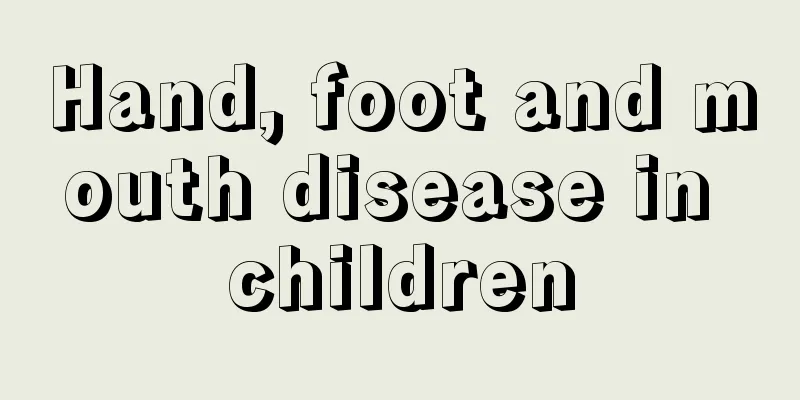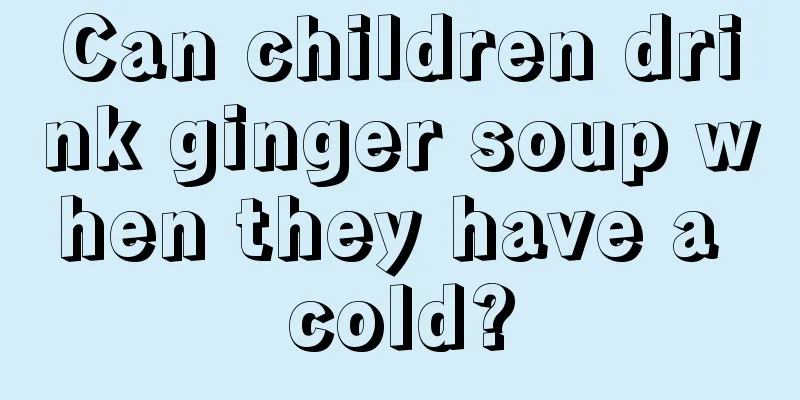Hand, foot and mouth disease in children

|
Hand, foot and mouth disease is a disease with a relatively high incidence rate among children. This disease not only brings great physical and mental pain to children, but if it is not treated in time, it will cause the disease to worsen and affect the baby's physical health to a greater extent. It is important to seek medical attention promptly after the onset of hand, foot and mouth disease. In addition, parents can also adopt certain dietary therapy and nursing measures to alleviate the child's condition and help the child recover soon! 1. The course of hand, foot and mouth disease in children The incubation period is 3 to 5 days, with prodromal symptoms such as low fever, general malaise, and abdominal pain. Within 1 to 2 days, painful millet- to mung bean-sized blisters appear in the oral cavity, pharynx, soft palate, buccal mucosa, tongue, and gums. They are surrounded by a red halo and break down into small ulcers. Due to the pain, the patient often drools and refuses to eat. At the same time, rashes also appear on the hands and feet. An indefinite number of blisters appear on the dorsal sides of the hands and feet, the dorsal edges of the fingers (toes), around the nails, and on the palms and soles. In addition to the hands, feet and mouth, they can also be seen on the buttocks and near the anus, and occasionally on the trunk and limbs. They dry up and disappear after a few days, and the rash does not itch or cause pain. Some children may develop generalized papules and blisters, accompanied by aseptic meningitis, encephalitis, myocarditis, etc. Generally, the course of the disease is good, with the whole illness lasting about 5 to 10 days. Most patients can recover on their own and the prognosis is good. 2. Diet therapy for hand, foot and mouth disease: 1. 1 carrot, 15g Imperata root, 1 section of bamboo sugarcane, 15g raw coix seed, 1 dose per day, decocted in water instead of tea. 2. 5 bunches of rush, 3g of cicada shell, 1 flower of kapok, 10g of chicken bone grass, 50g of lean pork, boil into soup and drink. 3. Lotus leaf porridge: 2 fresh lotus leaves, 50 grams of white rice. Chop the lotus leaves and cook them into porridge. The above dosages are for one child aged 3 to 6 years old. The dosage can be increased or decreased according to the age. 3. What foods are good for the body when it comes to hand, foot and mouth disease? Stage 1: Early stage of the disease. Mouthache and loss of appetite. Dietary tips: Mainly liquid foods such as milk, soy milk, rice soup, egg drop soup, etc. Eat small meals frequently to maintain basic nutritional needs. To reduce mouth pain when eating, the food should be neither too hot nor too cold, and neither too salty nor too sour. Here is a little tip - use a straw to reduce the contact between food and oral mucosa. Stage 2: Fever subsides. Mouth pain relieved. The diet is mainly mushy food. Example: Milk banana paste. Milk provides high-quality protein; bananas are easy to make into a paste and are rich in carbohydrates, carotene and pectin, which can provide heat energy, vitamins, and have a laxative effect. Phase 3: Recovery period. Eat more meals. The quantity doesn't need to be too much, but the nutrition should be high. For example, add a small amount of chopped vegetables, chopped tofu, chopped mushrooms, etc. to the egg custard. Resume normal diet in about ten days. There is also a saying "only vegetarian, no meat or fish". A completely vegetarian diet, excluding nutrients such as milk and eggs, will not provide adequate nutritional quality as it lacks high-quality protein. Antibodies are a type of protein, so a completely vegetarian diet is not appropriate. 4. What foods should not be eaten for hand, foot and mouth disease: 1. Avoid eating cold, spicy, sour, salty and other irritating foods. 2. During the treatment, you should be careful not to eat fish, shrimp or crab. |
<<: Children's tooth replacement period correction
>>: How to diagnose intestinal infarction in children
Recommend
Is it really good for children to learn Taekwondo?
Taekwondo is a very popular sport among children....
What are the things to pay attention to when choosing a cooling patch?
Whenever the seasons change, many people with low...
How to identify Down syndrome babies
Down disease, also known as Down syndrome, means ...
Is it okay to feed pig intestines to children?
Many people like to eat pig intestines, but you n...
How to deal with a child who has a fever and cold limbs?
Children have very poor physical constitutions. I...
What parts of the body should be moxibustioned for children with cough
Children don’t like to take medicine when they co...
What to do if the newborn is hot-tempered?
Everyone knows that babies who eat milk powder ar...
What’s wrong with my 2-year-old baby’s white spots on his fingernails?
The nails of a two-year-old baby at home are usua...
What is the cause of chicken breast in children?
If a naughty child has pigeon chest, you should p...
What can’t babies with enteritis eat? These foods should be avoided
If your baby suffers from enteritis, what he eats...
Why are the baby's leg lines asymmetrical?
Every woman hopes that her baby can grow up healt...
Baby's nasal congestion, nose and eye mucus
In winter, colds happen from time to time, especi...
Exercises that help children grow taller
Parents all hope that their children can grow tal...
What is good for children to eat for breakfast? Nutritional matching is very important
Mothers need to pay more attention to the nutriti...
What should we pay attention to when children have neurotic convulsions?
Children's neurotic convulsions are a relativ...









